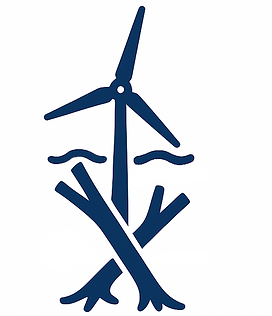
Applications
From habitat restoration to coastal defense, reintroducing large woody structures into marine environments unlocks powerful ecological benefits. Our tree-reefs are nature-based tools that reconnect land and sea, support biodiversity, and strengthen shorelines — all by building with nature, for nature.

Fish & Shellfish Habitat Restoration
Reintroducing driftwood, in the form of trees, to the sea reconnects land and water, creating structure and shelter for marine life where it’s been lost. Our tree-reefs mimic inputs of natural large wood to kickstart ecosystem recovery.

Fish Production
Tree-reefs provide essential complexity and refuge for fish to feed, grow, and lay eggs. By restoring lost underwater architecture, we boost biodiversity and support local fisheries from the bottom up.

Coastal Defense & Living Shorelines
Wood-based reefs help reduce wave energy and trap sediment, stabilizing shorelines naturally. Our structures combine ecological function with physical protection —
nature-based defense in action.

Seagrass Synergy
Tree-reefs lessen currents and waves, leading to greater sediment stability. This creates ideal conditions for seagrass to take root and expand, while creating habitat for fish which provide critical ecosystem services for the seagrass. A powerful partnership between wood and seagrass for cleaner, healthier coasts.

Offshore Energy
Artificial reefs beneath offshore energy and wind installations offer crucial habitat enhancement by creating elevated, complex structures on the seafloor. These reefs provide substrates for marine life to settle, such as mussels and oysters, and habitat for diverse fish and invertebrate communities. Integrating reef structures helps boost local biodiversity and supports the development of balanced, resilient ecosystems around offshore infrastructure.

Aquaculture
By introducing tree-reefs around aquaculture operations, we create stable habitat and enhance local food webs, attracting larger predatory fish that help maintain ecological balance. These fish can manage populations of opportunistic / "pest" species around seaweed and shellfish farms, promoting healthier farm environments. The structural complexity of reefs also provides shelter for juvenile fish and forage species, indirectly supporting aquaculture through natural ecosystem services.

Eco-Tourism
Tree-reefs reefs create vibrant underwater habitats that attract fish and invertebrates, making them ideal destinations for divers and snorkelers. These installations not only enhance marine biodiversity but also support sustainable recreational activities such as diving and recreational fishing.
By drawing visitors to restored marine areas, artificial reefs help promote conservation awareness while boosting local coastal economies.

Water Filtration
Mussels and oysters naturally attach to hard, stable surfaces like the complex branches of tree-reefs, where they form dense clusters. These filter feeders improve water quality by removing excess nutrients, plankton, and suspended particles from the water column. (A single oyster can filter 200 litres per day!)
When placed near stormwater or wastewater outflows, reef structures supporting shellfish can act as natural biofilters, reducing turbidity and contributing to healthier, clearer aquatic environments: acting as a tertiary treatment system while enhancing biodiversity.